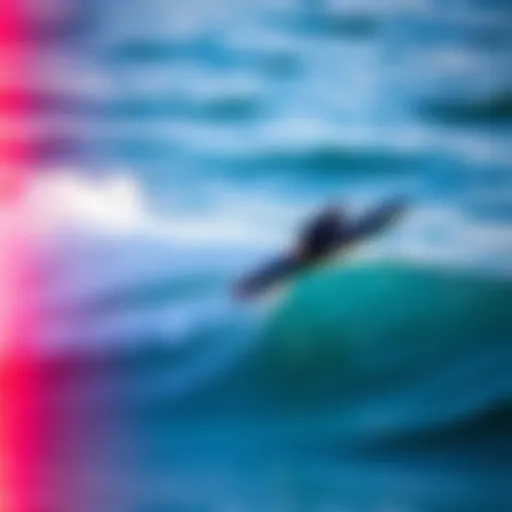Marine Forecast Insights for Charleston SC Kiteboarding
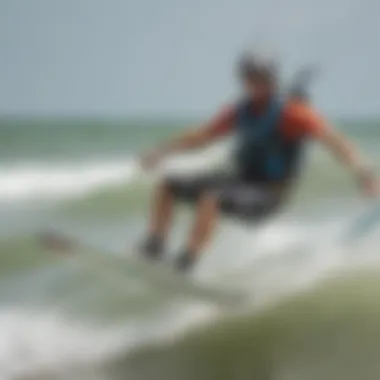

Intro
Kiteboarding in Charleston, South Carolina, is an exhilarating experience, and having a solid grasp on the marine forecast is key for anyone serious about this sport. As the sun rises over the coastal waters, kiteboarders flock to the beaches, ready to harness the wind and waves. However, what seemingly starts as a joyous day can transform into a challenge if not equipped with the right understanding of weather conditions, wind patterns, and currents. This article will shine a light on vital insights that can enhance both safety and performance for kiteboarding enthusiasts.
So, what can we expect? Knowledge about local conditions can be the difference between a breezy adventure and a day spent watching the tides from a distance. We’ll dive deep into essential elements including weather updates, local wind behavior, tidal movements, and the importance of safety measures, tailored specifically for kiteboarders of all levels.
Techniques
Understanding the right techniques is essential for a fulfilling kiteboarding experience. Whether you’re just starting out or looking to hone your skills, mastering the fundamentals and advancing to complex maneuvers is pivotal.
Beginner Kiteboarding Techniques
For novices, starting off on the right foot is important. Here are some key techniques:
- Body Dragging: Before taking your first ride on the board, practice body dragging. This technique allows you to get used to the kite's pull without the added complexity of balancing on a board.
- Water Starts: One of the first objectives for newcomers is learning how to rotate the board on your feet and stand up smoothly. Focus on keeping your weight centered over your board to avoid wiping out.
- Directional Riding: Once comfortable with water starts, work on heading downwind. Keep your kite steady and low to the water. Lean back and edge to maintain speed while aligning your body with the board.
Advanced Freestyle Maneuvers
After mastering the basics, it’s time to elevate your game:
- Kite Loops: A breathtaking trick where the kite is flown in a loop, creating immense pull. The key is to initiate the loop while maintaining control and finesse.
- Handle Passes: An advanced maneuver that involves passing the control bar behind your back while in the air. This requires perfect timing and awareness of your surroundings.
- Double Backrolls: For those looking to impress, try double backrolls. It takes perfecting your rotation skills in conjunction with managing the kite’s power.
"Kiteboarding is like dancing, but with the ocean as your stage and the wind as your partner. Each technique enhances your rhythm."
Gear Reviews
When it comes to kiteboarding, having the right equipment can make a world of difference. Understanding gear options is crucial for kiteboarders who want to maximize their performance and safety on the water.
Latest Kiteboarding Equipment
The advances in technology have birthed a range of exciting gear:
- Kite Models: Brands like Cabrinha and Duotone are known for their cutting-edge designs and performance capabilities.
- Boards: There’s a variety of boards suited for different styles—freestyle, wave, and all-around boards feature distinct builds for specific experiences.
- Harnesses: Comfort can’t be overstated. Look for harnesses from Mystic or ION, which offer excellent support and adjustments for all body types.
Essential Accessories for Kiteboarders
Accessories are often the unsung heroes of kiteboarding:
- Safety Leashes: Always opt for a quality safety leash to prevent kite runaway incidents.
- Impact Vests: These vests provide protection against hard landings while currently being lightweight and flexible.
- Sunglasses: Don’t underestimate the power of good UV protection. Brands like Blenders Eyewear offer stylish options that reduce glare and protect against sun damage.
End
Understanding the marine forecast along with techniques and gear specifics can unlock a world of adventure for kiteboarding enthusiasts in Charleston, SC. By enhancing your skill set and knowing what to expect from the elements, a kiteboarding experience can become more than just a ride; it transforms into an art form crafted by wind, waves, and willpower. Keep those skills sharp, check the forecast diligently, and most importantly, enjoy the ride.
Understanding Marine Forecasting
The shifting sands of our climate go hand in hand with the ebb and flow of the tides, making marine forecasting not just a useful tool, but an essential beacon for anyone looking to ride the waves. In Charleston, South Carolina, the often unpredictable marine environment puts kiteboarders in a prime position to gain not only thrilling experiences but also vital insights into safety and performance. To effectively navigate these waters, understanding marine forecasting becomes pivotal.
The Role of Marine Forecasting
Marine forecasting encompasses the prediction of various weather conditions over bodies of water. It involves analyzing data from multiple sources, including satellites, buoys, and local weather stations. Marine forecasters take into account factors like wind speed, air temperature, wave heights, and atmospheric pressure to generate a comprehensive forecast for specific locations. Tools like weather maps and radar imagery play a critical role in honing in on the most accurate forecasts.
Forecasting isn’t merely about predicting the weather. It serves a significant purpose – guiding all marine activities, from fishing to recreational rides on the water. For kiteboarders, understanding the role of marine forecasting doesn’t just mean knowing if it might rain. It’s about grasping how the interplay of wind patterns and tides will impact their day of fun on the water.
Importance for Kiteboarding
For kiteboarding aficionados, the importance of marine forecasting transcends beyond mere enjoyment; it shapes their entire kiteboarding experience. The wind is the lifeblood of this sport, affecting not only the performance but also the safety of the rider. A well-timed forecast can make the difference between a splendid day surfing the salty air and a precarious situation battling unmanageable winds.
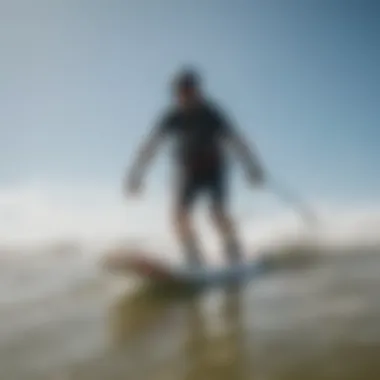

Some key aspects to consider include:
- Wind Speed: Light winds may fail to fill the kite adequately, while gusty winds can lead to instability, making control difficult.
- Wind Direction: Knowing whether the wind is onshore, offshore, or side shore is crucial. Each direction presents distinct challenges and opportunities for kiteboarders.
- Flash Floods and Storm Warnings: Local weather systems can change the game quickly, and being prepared for sudden squalls can mean the difference between a thrilling adventure and an unsafe encounter.
In Charleston, staying ahead of the weather with accurate marine forecasting isn’t just advisable; it's necessary. Understanding these forecasts is not only about improving performance; it’s about ensuring the safety of the kiteboarder, who must remain vigilant against the fickle nature of weather conditions that can change on a dime.
"Weather is not the enemy; it’s the guide when riding the waves. Knowing when to take off and when to stay ashore can save lives."
Overall, marine forecasting provides essential insights into conditions that can enhance or inhibit kiteboarding experiences in Charleston. Navigating this knowledge gives riders the power to make informed decisions, encouraging a more enjoyable and safe kiteboarding experience.
Marine Weather Conditions in Charleston
Understanding the marine weather conditions in Charleston is paramount for kiteboarding enthusiasts. The coastal winds, temperature variations, and precipitation trends can significantly influence kiteboarding experiences. These elements not only determine the quality of the water and wind but also affect safety outcomes. Kiteboarding in Charleston isn’t just about having fun; it’s about being prepared and making informed decisions based on the current and forecasted marine conditions.
Temperature Trends
Temperature is one of the first indicators of marine weather that kiteboarders should pay attention to. Charleston experiences a humid subtropical climate, leading to warm summers and mild winters. In summer months, temperatures can soar beyond eighty-five degrees Fahrenheit, creating inviting conditions for kiteboarding. However, the temperature of the water can vary—warmer days mean warmer water, but there's also an increase in humidity.
When the fall season rolls in, temperatures begin to drop. During this time, kiteboarders often prefer the slightly cooler winds. Therefore, tracking temperature trends allows riders to determine the best times to hit the water, whether for leisure or competition. Knowing when to expect a cool breeze or a hot spell can make all the difference in comfort and performance on the water.
Wind Patterns
Wind is the lifeblood of kiteboarding. In Charleston, wind patterns can be as varied as the seasons. The area is known for its coastal breezes that generally pick up in the afternoon when thermal winds start to flow. These breezes tend to be more favorable for kiteboarding since they provide consistent wind velocity and direction.
For instance, the seabreeze can typically range from 10 to 25 knots, depending on the day and location. Local knowledge suggests that the best kiteboarding days often align with late spring to early fall, when winds are more predictable and manageable. Moreover, understanding the specific wind patterns at different kiteboarding spots around Charleston can significantly enhance the experience. This means knowing the local spots where wind funnels can increase speed, or where gusty winds might pose challenges.
Precipitation Analysis
Precipitation is another critical factor affecting kiteboarding conditions. Charleston gets its fair share of rain, especially during the summer months. Thunderstorms can develop rapidly, often bringing strong winds and heavy rain. Should a storm roll in, it’s essential for kiteboarders to understand the forecast to avoid being caught off-guard.
Here are some points to consider regarding precipitation and kiteboarding:
- Timing: Check forecasts routinely to avoid riding when a storm is imminent.
- Equipment Care: Rain can potentially damage kiteboarding gear; hence, storing equipment properly afterwards is crucial.
- Water Quality: Heavy rain can affect water quality, leading to debris or pollutants in favorite riding spots.
"Knowing when to hang tight and when to take to the skies reduces the chance of risky situations while boosting enjoyment."
By regularly monitoring these weather conditions, kiteboarders not only prepare for a fantastic day on water but also elevate their safety. Amid the wind and waves, a thorough understanding of Charleston's marine weather conditions can ensure a fulfilling kiteboarding experience.
Key Factors in Kiteboarding Forecasts
Understanding the key factors in kiteboarding forecasts is crucial for enthusiasts who want to maximize their experience on the water. Clarifying these elements helps kiteboarders make informed decisions, ensuring not only enjoyment but also safety while riding. Key aspects like wind speed and direction, tide patterns, and current movements are intricately linked to how and when kiteboarders take to the seas. Let’s delve deeper into these components.
Wind Speed and Direction
Wind speed and direction serve as the backbone of kiteboarding conditions. Without the right breeze, the experience can shift from exhilarating to lackluster in no time flat.
- Optimal Wind Speed: Kiteboarders often look for wind speeds between 12 to 25 knots. Speeds lower than this may leave you sitting still, while anything over 25 can lead to a wild ride that may not suit beginners.
- Wind Direction: This is another essential element. Most kiteboarding locations in Charleston favor onshore or sideshore winds. These conditions provide a safer experience as they push riders back towards the shore instead of away from it.
- Gusts and Lulls: It’s important to keep an eye on gusts, which can cause sudden shifts in wind strength, as well as lulls that can leave you stranded. Evaluating local weather forecasts will provide insight into these variations.
Tides: Understanding Their Impact
The tides in Charleston can greatly affect kiteboarding conditions, making it essential for enthusiasts to understand their cycles. Tides run on a predictable schedule, influenced by the moon's gravitational pull, and they can change water levels dramatically.
- High and Low Tides: Typically, kiteboarders benefit more from mid-tide conditions, where there’s enough water to maneuver but not so much that you lose visibility on sandbars or oysters.
- Access & Safety: Some launching spots become perilous during low tide due to exposed rocks, mudflats, or sharp oyster beds. Understanding tide times can help in planning your session to ensure easy access and a safer landing.
"Kiteboarding is not only a sport; it's a dance with nature. Knowing the tides can truly be the difference between a thrilling adventure and a headache."
Current Patterns and Their Effects
The influence of current patterns on kiteboarding cannot be overlooked. These underwater flows can change based on wind, tide, and even weather events. Understanding them can lead to a more enjoyable and safe experience.
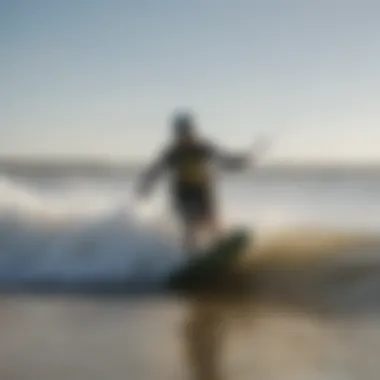

- Types of Currents: In Charleston, you may encounter tidal currents that flow in and out of the inlets. These currents can be especially swift around the period of high tides.
- Impact on Riding: Fast currents can carry you farther from your desired path, affecting how you plan your ride. If you know the currents, you can ride with them for longer sessions or move strategically against them to return to your launch point.
- Navigational Choices: Being savvy about current patterns also helps in choosing your launching and landing spots. Some areas might be sheltered from strong currents, while others may present tricky conditions.
By grasping these key factors—wind speed and direction, tides, and current patterns—kiteboarding enthusiasts can navigate the waters of Charleston with confidence, optimizing their sessions for both safety and enjoyment.
Utilizing Forecast Tools
For kiteboarding enthusiasts, having the right tools at their fingertips can make all the difference in the world. Utilization of forecast tools not only enhances the experience but also plays a crucial role in ensuring safety. When enjoying the waters of Charleston, the ability to quickly access accurate weather predictions allows riders to capitalize on optimal conditions while avoiding problematic situations.
Effective forecasting can steer kiteboarders towards better performance. There’s a multitude of available resources—from online platforms to mobile apps and local weather stations. Understanding how to leverage these tools is essential for making informed decisions.
Online Resources
The internet is brimming with websites dedicated to marine forecasts. Sites like NOAA (National Oceanic and Atmospheric Administration) offer comprehensive insights into weather patterns. Additionally, specialty kiteboarding forums and community boards provide real-time updates shared by fellow kiteboarders. This peer-based knowledge, combined with official forecasts, can form a quite robust picture of conditions.
Key features to examine include:
- Wind Speed and Direction: Different days might present varied wind conditions. Knowing what to look for can help you decide if it’s worth heading out.
- Wave Height and Condition: Preferable wave heights can differ depending on the experience level of the kiteboarder.
- Tidal Movements: Understanding the tides can significantly impact the accessibility of certain kiteboarding locations.
Mobile Applications
In today's fast-paced world, having access to real-time data is invaluable. Mobile applications designed for weather tracking offer a convenient way to stay updated while on the go. Apps like Windy or iKitesurf provide detailed information on wind conditions and can even send alerts based on your preferences.
Some benefits of these mobile applications include:
- Push Notifications: Instant alerts inform you when conditions are favorable, so you won’t miss a prime opportunity.
- Customizable Dashboards: You can tailor the app to focus on the specific variables that matter to you the most, be it wind speed, tide information, or precipitation.
- Interactive Maps: Visual representations help you to scout suitable locations quickly as conditions change in real time.
Local Weather Stations
Despite the advancements in technology, often the most reliable data can come from local weather stations. By relying on localized information, kiteboarders can achieve a better understanding of what to expect in their immediate area. Local stations tend to provide more micro-focused data compared to broader forecasts from national services.
Key advantages of local weather stations include:
- Timely Updates: They are often faster to report unusual weather patterns, which can be crucial for safety.
- Accuracy: Localized data can provide a clearer picture of conditions, especially around the water where variables can fluctuate frequently.
- Community Knowledge: Engaging with local observing networks or communities can create a wealth of experiential information that apps and websites may not capture.
"Utilizing forecast tools effectively allows kiteboarders to navigate the waters with confidence, knowing they have the current information at their fingertips."
By grasping the nuances of these tools, kiteboarding enthusiasts in Charleston can enhance their experience and also safeguard their riding adventures, ensuring they get the best out of their time on the water.
Safety Considerations in Marine Environments
Kiteboarding in Charleston offers an exhilarating experience, but it also comes with its own set of challenges and risks. Understanding safety considerations is key to protecting oneself and others while enjoying this sport. By grasping the nuances of hazardous marine conditions and being well-prepared for emergencies, kiteboarders can minimize risks and fully enjoy their time on the water.
Understanding Hazardous Conditions
When venturing out for a day of kiteboarding, the first step is to assess the safety of the marine conditions. Hazardous conditions can crop up unexpectedly. High winds, strong currents, and sudden changes in weather can turn a blissful day into a precarious situation.
- Wind Speed and Direction: Kiteboarding thrives on wind, but winds that are too strong or gusty can be dangerous. Understanding the limits of your equipment and skill level ensures safer rides. For example, winds exceeding 25 knots may be too extreme for even experienced riders.
- Currents: Charleston’s coastal area is known for its unique currents. When the tide is coming in or going out, the currents can dramatically influence how a kiteboarder maneuvers through the water. It’s vital to know the tide charts and predict when strong currents may occur.
- Visibility and Weather Changes: Overcast skies or approaching storms can pose visibility issues. Always check local weather reports before heading out, paying attention to predictions of rain or lightning. The phrase "when in doubt, stay out" rings true here.
By familiarizing oneself with local patterns and potential risks, kiteboarders can avoid precarious situations.
Emergency Preparedness
Despite all precautions, accidents can and do happen. Preparing for emergencies is as crucial as enjoying your ride. Here are steps to bolster your readiness:
- Know Your Environment: Familiarize yourself with the local waterways. Knowing where to find safe areas for landing or taking refuge can be invaluable during an emergency.
- Reach Out to Local Community: Connecting with local kiteboarding groups not only enriches the experience but also equips you with knowledge about potential hazards and safe practices. This could be a local Facebook group or Reddit communities where kiteboarders share experiences and tips.
- Safety Gear: Always wear appropriate safety gear. This includes helmets, life jackets, and impact vests. Everyone should have a personal flotation device, and it’s helpful to carry a whistle or a signaling device in case of distress.
- Communication Plans: Before you hit the waves, inform someone about your plans. Let them know where you’ll be and how long you expect to be out. In case of emergency, having an extra hand on land can be a lifesaver.
- Emergency Contacts: Keep a list of local emergency contacts handy. This includes the Coast Guard, local harbor authorities, and emergency medical services. Knowing who to call when things go awry can save precious time.
In summary, while kiteboarding in Charleston is thrilling, it’s essential to recognize and prepare for the potential risks involved. Knowledge and proper preparation can transform a hazardous situation into a manageable one, ensuring that the excitement of riding doesn’t come with unnecessary peril.
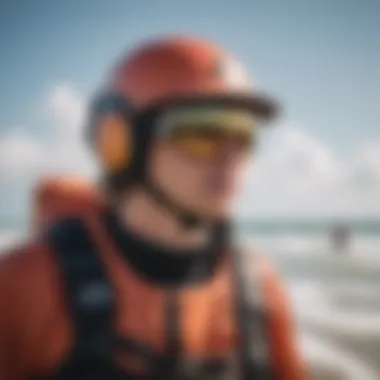

"It's not just about catching waves; it's about ensuring you're safe while riding them."
Harsh conditions can lead to unexpected endings. But with the right approach, kiteboarding can stay a positively unforgettable activity.
Charleston’s Kiteboarding Hotspots
When it comes to kiteboarding, the right location can make or break the experience. Charleston boasts some prime spots for kiteboarding enthusiasts, each offering unique conditions that cater to different skill levels and preferences. With its diverse landscapes, from wide-open beaches to sheltered areas, Charleston provides a variety of kiteboarding environments.
Kiteboarding is more than just a sport; it’s about connecting with nature and that rush you feel gliding across the water. Hence, selecting the right hotspot can enhance your ride, making it smoother and more enjoyable. In this section, let’s dive into specific locations based on weather and local events.
Best Locations Based on Weather
Charleston features numerous kiteboarding spots that thrive under specific weather conditions. Here are some standout locations:
- Folly Beach: Renowned for its consistent winds, Folly Beach is a go-to for both seasoned and novice kiteboarders. The beach faces southeast, making it ideal for east and northeast winds. The waves provide a thrilling challenge, especially during summer afternoons.
- Sullivan’s Island: This spot has a tranquil vibe and caters mainly to intermediate riders. The shallow waters create a safer environment, allowing riders to practice tricks without the fear of deepwater hazards. However, it’s crucial to be aware of the local wildlife – especially when nesting season is on.
- Isle of Palms: Known for its vast open spaces, this hotspot offers plenty of room to launch and land kites. The wind patterns here are particularly favorable during the spring and fall months. On a sunny day, you might find people riding out under perfect blue skies while the winds stay steady at 15-20 knots.
Local Events and Competitions
Beyond just the on-water experience, displaying skills is an exhilarating part of kiteboarding. Charleston frequently hosts local events and competitions that not only highlight the talents of riders but also bring the community together.
- Kiteboarder’s Day Out: An annual event where riders unite to celebrate the sport. Participants engage in friendly competitions, skill workshops, and demos by experienced riders. It’s a fantastic opportunity for newbies to learn and network with seasoned kiteboarders.
- Carolina Kite Fest: This is a highlight on the local kiteboarding calendar, attracting riders from all over the region. Held at Folly Beach, the fest features races, trick competitions, and even kite art displays. Besides showcasing kiteboarding prowess, it’s also a celebration of coastal culture with food trucks and live music.
Local events like these not only enhance the kiteboarding experience but also foster community spirit and camaraderie among riders.
Culmination
Choosing the right hotspot in Charleston is crucial for optimizing your kiteboarding adventure. With its blend of natural beauty, favorable wind patterns, and vibrant events, every kiteboarder can find their perfect spot. So grab your kite and hit the water, you'll not only enjoy the thrill of riding but also build connections and memories in this stunning coastal city.
The Future of Marine Forecasting
As we look ahead, the realm of marine forecasting is evolving at a rapid pace. For kiteboarding enthusiasts and other water sports participants, grasping the nuances of these changes can mean the difference between a perfect day on the water and a troublesome one. This section delves into what the future holds, focusing on technological advancements and user engagement trends that promise to reshape how we access and interpret marine forecasts. As we consider these factors, it's vital to recognize how innovation can enhance predictive accuracy and overall experience.
Advancements in Technology
In recent years, technology has transformed how we understand marine conditions. Gone are the days of solely relying on local tidbits or guesswork. Today, we have access to advanced forecasting models that utilize diverse data streams, including satellite imagery and real-time oceanographic information.
One area where technology shines is through the use of Artificial Intelligence (AI). AI algorithms can analyze vast amounts of historical data to predict future conditions with impressive accuracy. For kiteboarders, this translates into more reliable forecasts, allowing riders to plan their sessions with confidence. If wind patterns are accurately predicted, kiteboarders can choose the perfect day to catch the best waves.
Moreover, advancements in mobile technology mean that access to marine forecasts is always just a tap away. Apps and specialized platforms offer real-time updates, alerts, and visualizations of forecasts tailored specifically for water sports. Riders can check locations and conditions while on the road, ensuring they never miss out on optimal conditions. This level of convenience and accuracy emphasizes the importance of staying connected to the ever-changing marine environment.
Trends in User Engagement
Shifting gears a bit, let’s talk about trends in how folks engage with these forecasts. It's not just about getting the info anymore; it's about how the community interacts with it. Users are looking for more than statistics; they want a comprehensive understanding. This has led to an increase in platforms encouraging user-generated content, where kiteboarders share experiences, conditions, and even tips.
Social media platforms such as Facebook and Reddit have become popular venues for kiteboarders to swap information on weather conditions, share local insights, and even post real-time updates. These interactions can create a real sense of community among enthusiasts and help riders avoid windy disasters.
Moreover, education is key. Websites and apps increasingly provide educational material on interpreting forecasts. A deeper understanding of wind and tide reports leads to smarter decisions. As the adage goes, "knowledge is power," and for kiteboarders, being savvy about the marine environment can enhance both safety and performance. Knowing when to take risks and when to hold back might just save a kite or prevent a mishap.
With all these elements at play, the future of marine forecasting looks promising. As kiteboarding continues to grow in popularity, harnessing these advancements in technology and engaging users will ultimately allow for safer adventures on the water.
Culmination and Takeaways
The journey through the intricacies of marine forecasting in Charleston reveals its undeniable significance for kiteboarding enthusiasts. It’s not merely about checking wind speed or wave heights; rather, it’s the essence of understanding how these factors dance together to create the ideal kiteboarding conditions. This final section wraps up the key insights and emphasizes the importance of applying this knowledge in practical settings.
Summarizing Key Points
Throughout this article, several critical elements have been highlighted:
- Understanding Weather Patterns: Familiarity with how local weather systems operate can directly influence kiteboarding enjoyment. For instance, recognizing shifting wind patterns before they hit the shore can save time and enhance safety.
- Vital Role of Tides: Tides significantly affect water depth and shore accessibility. Knowing tide schedules helps in planning rides during optimal conditions while avoiding hazardous areas during high tide.
- Utilizing Multiple Resources: The array of online tools and mobile applications available can help kiteboarders stay informed and prepared for changing conditions. Reliable apps provide real-time updates that are crucial for an enjoyable experience.
- Safety First: Understanding hazardous conditions is paramount. Kiteboarding is exhilarating, but it can also be risky. Being aware of local safety guidelines and preparing for emergencies can make all the difference.
Encouraging Responsible Kiteboarding
While the thrill of kiteboarding on Charleston's vibrant waters is undeniably appealing, it is equally vital to champion responsible practices. This encompasses both safety and environmental considerations:
- Environmentally Conscious Riding: Kiteboarders should be mindful of marine ecosystems. This includes avoiding sensitive areas, minimizing impact on local wildlife, and not leaving trash on the beach. Small actions contribute to preserving the natural beauty that draws enthusiasts from far and wide.
- Community Engagement: Participating in local events fosters a sense of belonging and encourages responsible riding. Connecting with other kiteboarders can facilitate shared knowledge about conditions and best practices for safety and respect for others out on the water.
- Continuous Education: Always look to expand your understanding of marine conditions and safety protocols. Whether attending workshops or engaging with community forums on platforms like Reddit, ongoing learning ensures that you stay informed and equipped for the adventures ahead.

